-
收藏模板
- 模板信息
- 更新时间:2023-09-10
- 字数:约40192字
- 页数:约26页
- 格式:.doc
- 推荐版本:Office2016及以上版本
- 售价:5 金币
您可能喜欢的文档
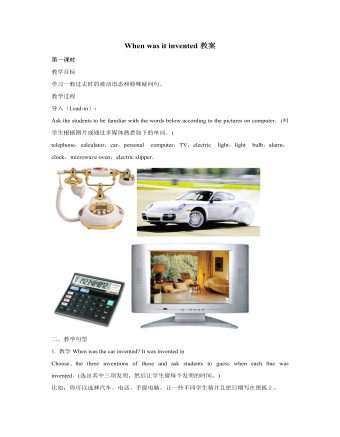
人教版新目标初中英语九年级下册When was it invented教案
二、教学 1a,1b.1.First the teacher asks the students what kind of fruit food and drink you like the best and writes down on the blackboard.教师问学生最喜欢什么水果和饮料并把它们写在黑板上。比如:potato chips,ice cream,tea,lemon,chocolate,oranges,salad,popcorn,pickle and so on.2.接着叫学生表达以上食物的味道,引出新单词——sweet,crispy,salty,sour,delicious,hot,awful,nice…并且完成lb教学内容通过此活动,以旧带新引入新单词。其目的是让学生自主学习新知识。 三、教学 2a,2b1.首先,听力前的brainstormFirst,Let students describe how potato chips taste and describe how helpful the potato chips.Then,ask:When and where were potato chips invented?Who were potato chips invented by?How were potato chips invented?(Let students guess according to the following key words.)Key words:by accident,customer,restaurant,by mistake.(说明:通过问题让学生对对话内容有整体了解,为听力练习做好准备;又培养学生的注意力,想像力,观察力。)
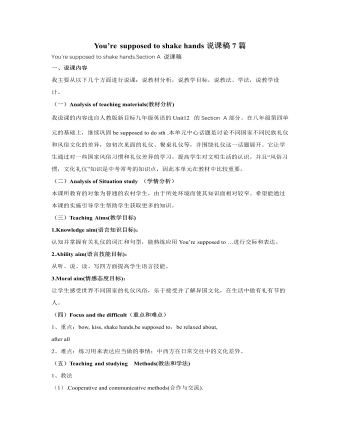
人教版新目标初中英语九年级下册You’re supposed to shake hands说课稿7篇
二 、教材分析本单元主要是通过对一些国家的风俗习惯、礼仪差异、时间观念和饮食文化的学习,进一步提高学生对文明生活的认识;加深学生对中外文化的了解,拓展学生的文化视野,为学生阅读相关方面的文章奠定一定的文化基础。我们知道近几年来有关风俗文化,生活习惯的 阅读内容一直是中考热门的话题之一。通过本单元的学习,学生可以掌握一定的相关方面的知识,为今后在阅读积累必要的信息。在Section A 当中出现的 be supposed to 句型为重点句型,此句型的语法结构为被动语态。被动语态也是历年来中考基础命题必考的内容之一。比如,去年的中考试题,在基础选择部分试题中就出现了对此语法结构考查。Section A 首先通过一些图片和句型来让学生初步了解本单元的语言目标。然后,通过练习进一步加以巩固。接着通过一组听力练习,来训练学生的听力,同时,学生可以具体了解到不同的国家在风俗习惯等方面有着怎样的不同。为下面的学习进行铺垫,同时激发学生了解更多的相关知识的学习兴趣。
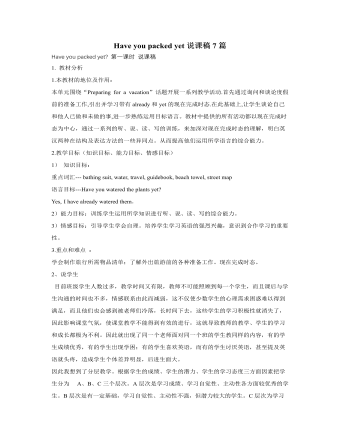
人教版新目标初中英语九年级下册Have you packed yet说课稿7篇
二 说学情 “以学生的发展为本”的新课程理念,要求教学必须以学生的学习基础、学生需要、学习兴趣等为出发点,联系学生的现代校内外生活,让课堂教学成为学生生命成长和个性张扬的过程。要实现以“学生为本”的理念,教学中必须要做到充分地预设学情。初三学生已经具备了一定的语言基础及语言表达能力,大部分学生对英语还有着比较浓厚的兴趣。同时,在长期的新课程理念熏陶及实践中,已经初步具备了自主,合作,探究的能力。本课教学内容与学生的实际生活密切相关,易于引发学生运用简单的英语进行交际和交流。通过八年级下册第九单元“Have you ever been to an amusement park?”的学习,学生已初步了解现在完成时的基本特征和结构,也比较熟悉“has/have been to…”的句型,这非常有利于本单元教学活动的开展。在此基础上,本单元以“Preparing for a vacation”和“Favorite band”等贴近学生实际生活的内容为话题,继续学习带有already与yet的现在完成时态,较快地激发学生的学习积极性,达成本单元的教学目标。
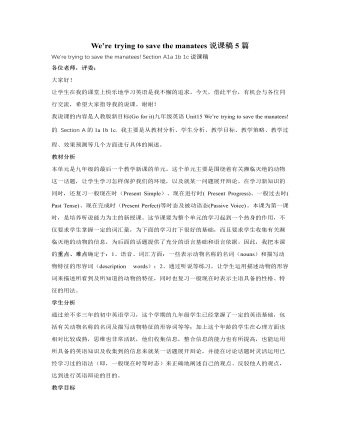
人教版新目标初中英语九年级下册We’re trying to save the manatees说课稿5篇
教材分析本单元是九年级的最后一个教学新课的单元。这个单元主要是围绕着有关濒临灭绝的动物这一话题,让学生学习怎样保护我们的环境,以及就某一问题展开辩论。在学习新知识的同时,还复习一般现在时(Present Simple)、现在进行时( Present Progress)、一般过去时( Past Tense)、现在完成时(Present Perfect)等时态及被动语态(Passive Voice)。本课为第一课时,是培养听说能力为主的新授课。这节课要为整个单元的学习起到一个热身的作用,不仅要求学生掌握一定的词汇量,为下面的学习打下很好的基础,而且要求学生收集有关濒临灭绝的动物的信息,为后面的话题提供了充分的语言基础和语言依据。因此,我把本课的重点、难点确定于:1、语音、词汇方面:一些表示动物名称的名词(nouns)和描写动物特征的形容词(description words);2、通过听说等练习,让学生运用描述动物的形容词来描述所看到及所知道的动物的特征,同时也复习一般现在时表示主语具备的性格、特征的用法。

人教版新目标初中英语九年级下册I’ll help clean up the city parks说课稿5篇
二、教法学法1、任务型教学法:每个教学环节都是围绕着如何完成一个教学任务来设计的。2、感悟法:创设语境,让学生在一定的语言环境中感悟语言内涵,从而实现悟中学的目的。只有学生自己悟出的东西才能较好地内化为自己的东西。3、合作点拨法:通过教师创设的学习氛围,设置问题和反思质疑,推动师生,生生间的合作探究,小组合作学习,在解决问题中完成教学目标。以培养他们的合作探究的意识与精神。三、教学程序1 导入新课利用课件中的图片导入:在大屏幕上出示汶川大地震中一些悲惨的图片,让同学们说出汶川,然后老师说as well-know a stong earthquake happened in wenchuan,so many kind people go there to help others.再出示一些军人,医疗工作者,志愿者忙碌的身影,特别是温家宝总理看望受伤的孩子,让同学们知道一方有难,四方支持,帮助困难中的人是很有意义的。然后说Would you like to help others?What would you like to do?
- 查看更多相关Word文档
When was it invented说课稿7篇
When was it invented?第一课时 说课稿
一.教材分析
1.教材的地位和作用
本说课是九年级《go for it》第九单元“When was it invented?”本单元涉及内容是本书当中比较重要的一部分。被动语态结构及运用是教学中一个难点和重点,也是学生比较不容易理解的部分,因为它是建立在各种时态之上的。
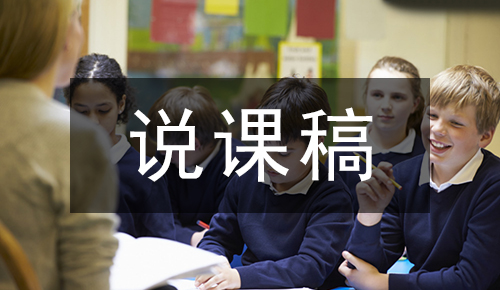
另外通过对我们熟悉经常使用的发明物的历史来开阔眼界,丰富学生的阅历,使学生养成勤于思考,善于总结的好习惯。
2.教学目标
1)知识目标 扩容新单词,提高阅读能力。理解和良好运用被动语态。
2)技能目标 能谈论重要发明的历史及用途,能针对各项发明的用处及特点,发表自己的看法,并说明理由。
3)情感目标 使学生懂得人类的科学发明创造了丰富的物质文明。培养学生的创造发明的能力和愿望
3.教学重点 掌握一般过去时的被动语态
4.教学难点 弄清主动语态与被动语态的差异,通过练习和运用加以巩固
二.学情分析
1.初中生的抽象能力较低,形象思维能力强。但注意力容易分散。本单元通过多媒体课件和教师亲和力的语言,增强兴趣和注意力。
2.初中生的学习心理特点
1)兴趣对英语普遍感兴趣,求知欲盛。
2)记忆对刺激记忆手段多的知识记忆深刻,遵从记忆规律。
3)评价主要通过他人评价初步形成对自己的评价,所以很在乎他人的评价。同时自我意识不断增强。因此在本课教学过程中,注意采用任务型教学为主,通过任务和不同的评价方式,提高学生参与意识。
3.初三上学期学生有较明确的学习动机和态度。本单元通过发明为载体,各种发明和发明家激励学生求知的欲望。
三.教法渗透
1、教学设计思路与教材处理:
《新目标英语》中的具体语言目标是通过各种各样的Tasks来实现的;学生需要运用具体而特定的行动来完成一定的交际任务。整个教学过程中,各种语言结构与语言功能与不同的学习任务有机的结合。任务活动所谋求的效果不是一种机械的语言训练,而是侧重在执行任务中学生自我完成任务的能力和策略的培养;重视形式在完成任务过程中的参与和在交流活动中所获得的经验。因此本节课我将始终引导学生通过完成具体的任务活动来学习语言,让学生为了特定的学习目的去实施特定的语言行动,通过完成特定的交际任务来获得和积累相应的学习经验,让学生在用中学,在学中用。
2、教学原则
l 活动性原则提倡学生主动参与,体验,交流,合作,探究等多种学习。
l 合作性原则以学生为主体,师生合作,生生合作,体现教与学的互动,交往。
l 任务型原则任务驱动—激发动机;任务完成—激励学习积极性;执行任务—培养责任心和合作精神。
l 情感性原则激发学生学习英语的兴趣和始终保持良好的学习情绪。
3、教法运用:
本单元主要采用任务型教学
在本课的任务型语言教学中,我将依据课程的总体目标并结合教学内容,创造性地设计贴近学生生活实际的任务活动,吸引和组织他们积极参与,使学生通过观察、思考、讨论、交流和合作等方式,在一种自然、真实或模拟真实的情境中体会语言、掌握语言的应用。
4.教学手段
1)多媒体辅助:使用自制的课件,使抽象的语言变得直观,为学生运用英语进行交际创设情景,实现师生互动,生生互动和人机互动的多向交流。
2)非测试性评价:传统的评价观念的出发点是学科本位,只重学科,不重学生发展。要体现新课程标准的实施效果,评价体系应该“正确反映外语学习的本质和过程,满足学生发展的需要”。为了达到这一目标,唯有重视形成性评价,充分发挥其积极作用,促进新的评价体系的形成。因此,本课我将各种活动设计成小组活动并开展小组竞赛和填写课堂自我评价表等非测试性评价手段,帮助学生学会自主学习,学会与人合作,培养创新意识以及具备科学的价值观。
四、学法指导
新制定的《英语课程标准》把“培养学生学习英语的兴趣,树立自信心,培养良好学习习惯和形成有效策略,发展自主学习和合作精神”放在了首位。依据课改的精神,我从以下几个方面对学生进行学法指导。
1、学习方法的指导
培养学生观察力,想象力,记忆力以及思维能力。用生动的课件调动学生的感官进行听说读写的训练。
2、学习积极性的调动
我在教学过程中创造一种开放的,和谐的,积极互动的语言氛围,把课堂变成有声有色的舞台,让学生在乐中学。
3、学习能力的培养
通过连贯的听说读写,游戏,竞赛等,培养学生的交际能力,发展他们的思维能力。
4、学习策略的指导
本节课将在课堂活动中把学生分成四人小组的学习小组,让他们围绕着课堂任务分工合作,在活动中相互探讨、相互交流、相互合作,从而获得知识、技能和情感体验,发展他们的能力。创建开放式,探究式的课堂,有意识渗透学习策略的训练。我让学生观察课件画面,回答问题,让学生学会使用认知策略;让学生表演对话,实现交际策略;引导学生交际,主动练习和实践,是调控策略的体现。充分利用多媒体,录音,卡片等是资源策略。
五.教学效果预测;
1.能够掌握被动语态,并运用到一定的语言环境。
2.通过多媒体和任务的完成学生会突破难点,产生一定创造精神。
3.能完成教学目标,调动学生学习热情。
六.课堂教学过程:
Ⅵ.Teaching Procedures
Step Ⅰ Lead-in (2 minutes)
We have inventions everywhere .Inventionsmake us live easily and happily. Without inventions,our lives will be much moredifficult. Today, we will know about a few inventions and talk about thehistory of them.
Showthe pictures of five inventions on the screen: a car,a Tv set, a telephone, acalculator and a computer.
T:Nowlook at these things.What are they?In what order do you think they wereinvented? Number them(1-5) (1=first,5=last)
Volunteersreport the answers.
S1:Ithink the calculator was invented before the computer.
S2:Idon’t think so. I think the calculator was invented after the computer.
Step Ⅱ 1a
This activity reviews vocabulary andintroduces new vocabulary which can be used to talk about inventions.
Read the inventions to the students.
Call the students attention to the five pictures. Tell thestudents that all of these things were invented in the last 150 years. Point toeach picture and let the students tell what it is.
Write the names of the five inventions on theblackboard.
computer, car, calculator, telephone, TV set
Have several different students guess andwrite the dates on the board.
Ask the class to repeat the questions andanswers like this.
T: When was the computer invented? Classrepeat.
Ss: When was the computer invented?
T: Good. Now Tom, what is your guess?
S1: 1965.
T: OK. Tom, repeat after me. The computer wasinvented in 1965.
T: Class, please repeat.
Ss: The computer was invented in 1965.
Repeat the process with several differentinventions.
Tell the children that they will find out thereal dates after they complete the lesson.
After that, ask the students the questionsbelow:
Questions:
1.Which one do you think is the oldest?
2.Which one is the newest?
3.Which one do you think is the oldest or the first invention?
4.Which one is the newest or last invention?
Ask different students to answer thequestions.
Have the students look at the exampleconversation in the box. Ask two students to read this conversation to theclass.
A: I think the telephone was invented beforethe car.
B. Well, I think the telephone was invented after the car.
Read the instructions again to the students.Remind them to remember the inventions from first to last.
Then have the students talk about the fiveinventions in groups of four, using the sample conversation as a model.
Ask several groups to tell the class theiranswers. The rest of the class listen to them and show they have differentanswers by raising their hands.
In the next activity you will find out thereal dates.
Step Ⅲ 1b
This activity gives students practice inunderstanding the target language in spoken conversation.
Get the whole class to read the instructiontogether.
Call the students attention to the five inventions in thepicture. Ask five students to say the names of them.
Then ask them to see the five dates with ablank line in front of each.
Well listen to a girl and a woman talkingabout the five inventions. They will talk about when they were invented. Listencarefully and match the inventions and the dates. Write the correct letter infront of each date as the sample given. Ask them to have a look at the sampleanswer. Tell them the answer in front of 1876 is d. That means that thetelephone, which is letter d, was invented in 1876. Play the recording thefirst time. The students only listen and try to catch the main idea.
Play the recording a second time. Let thestudents match the inventions and the dates. Check the answers by askingseveral to say the answers to the class.
If some of the answers are hard to get forthe children, tell them not to worry and they will make it next.
Then play the recording again. Pause aftereach sentence and let the students repeat. For some difficult sentences, getthe students to repeat several times. Be sure that they make everything clear.
Answers
d 1876 a 1885 e 1927 c 1971 b 1976
Step Ⅳ 1c
This activity provides guided oral practiceusing the target language.
Read the instructions and point to the listof dates in Activity 1b.
You will be talking about the dates thingswere invented with a partner.
Call the students attention to the example in the box. Ask apair of the students to read this conversation to the class.
SA: When was the telephone invented?
SB: Ithink it was invented in 1876.
Write the conversation on the blackboard.Then get the students to practice in pairs, using the information in Activity1b. Tell them to do it like this:
Student A, covers the dates. Students B, asks Student A when the things in the picture above were invented. Thenchange roles and practice again.
Ask several pairs to share theirconversations with the class.
Step Ⅴ Summary
In this class, weve learned to talk aboutthe history of inventions with passive voice. Weve also done some listeningpractice in understanding the target language in spoken conversation. And wevedone much oral practice, using the target language.
Step Ⅵ Homework
1.Write out two conversations in Activity 1a.
2.Write out two conversations in Activity 1 c.
Step Ⅶ Blackboard Design
When was it invented?
Section A
The First Period
1.The names of the five inventions:
computer, car, calculator, telephone, TV set
2.Target language:
A: When was the telephone invented?
B: I think it was invented in 1876.
When was it invented? SectionA(1a—1c) 英文说课稿
Good morning, everyone. It’s my pleasure to interpret my lesson heretoday. The lesson I’m going to talk about is the first period of Book 9 Whenwas it invented? I’ll describe my thoughts on teaching this lesson in thefollowing 4 aspects: analysis of teaching material, ways of teaching andlearning, teaching procedures and blackboard notes.
First of all, I’d like to give some analysis of the material and thestudents. This material is from Book 9 When was it invented? The language goal of this unit is “Talk aboutthe history of the inventions”.
In this period, students will get in touch with the passive voice. It’sthe first time for the students to get in touch with the passive voice. Thisgrammar item is a key point also is a little bit difficult. In this period, Iwill mainly let the students touch with the passive voice. They realizeinitially what the passive voice is constructed and what it expresses. Thatwill be OK. I make "talk about the history of inventions" as thelanguage goal of the class.
OK, that is all about my analysis of material. And then I want to talksomething about the students. In our school, the students dont have much timeto learn some inventions. So I ask them to get ready for this lesson and try tofind information about the four greatest inventions of ancient China and someother famous inventors and their inventions. So they can have a concert of whatthey will learn in this class. I hope the students can hit the following goalsafter this class: they can realize the passive voice initially; they can usethe sentence structures learned to discuss the inventors and their inventions;they can realize the ancient civilization of China, strengthen the proud offeeling.
According to the learning material and the analysis of the students, alsoon the basis of NE C, I set the learning objectives as follows.
By the end of this session, most of the Ss will be able to achieve thefollowing aspects. First of all, most of the Ss will be able to learn and usesome important language points, like calculator, bulb, invent, inventor,invention and so on. Second, Ss will be able to use the following sentencepatterns to talk about inventions: When was the car invented? It was inventedin…Who was the car invented by? It was invented by.... Third, Ss will be ableto write an article about great invention.
These are my teaching and learning objectives. And the focuses lie onhelping Ss improve their ability to find out the information they need afterlistening, and the ability to write an article about a great invention, usingthe passive voice. The difficulty is the using of the passive voice.
Then let me say something about the teaching methods. In order to reach myobjectives, I’ll design some pair works and group works to increase Ss talkingtime on the basis of the student-based teaching method. And I’ll design sometasks to improve Ss’ listening and writing skills mentioned above, on the basisof task-based teaching method. Besides, in order to make the lesson lively andinteresting, I’ll try to use modern equipments.
Ok, so much for the learning strategies. Next comes to my most importantpart, the learning procedures. My Ss will learn the lesson in 7 steps.
Step one is warming-up. First, I’ll greet the Ss with daily conversations.And then I’ll show them some pictures of the ceremony (2008 Olympic Games ) onthe screen to talk about the Chinese history and the four great inventions.
Then I’ll show the pictures of the four great inventions, and askstudents: Who invented …? And then present the new sentence patterns: -Who wasthe paper making invented by ? -It was invented by Cai Lun. -When was itinvented ?- It was invented in Donghan Dynasty After that, ask students to ask and answer inpairs, using the above sentence patterns.
Then I’ll say that we have known some ancient inventions, ask Ss “ Do youknow any modern inventions?” Ask Ss to tell as many as they can, such as car,telephone, light bulb, computer and so on. And then ask Ss: “When were theyinvented? And who were they invented by?” So we will come to step 3. Ss mayfind out the answer after listening.
After the third step, I’ll show more inventions on Bb, and ask Ss todiscuss them in groups of four. Then give a report. Ss should use the followingsentence patterns while they are talking.
- When was the laser invented?- It was invented in
- Who was it invented by?- It was invented by
InventionsWhen was it invented?Who was it invented by?
Laser1960Tony
airplane1903Light
E-mail 1971Tomlinson
telegraph1895Marconi
air-conditioner 1902Wailers
auto- dub machine1967Belon
ball pen1938Parishes
After the discussion part, we’ll go to step5-writing. Because after thelistening and discussion, it’s time for Ss to write something about aninvention. But first I’ll give Ss some oral examples about it. And examples cangive these students who are not good at English some help. And this oralpractice can make them easy to write the article. After the oral practice,we’ll come to write the article about a great invention. Before Ss write it,first I’ll help them how to begin the article. This can improve Ss’ learningstrategy. Before Ss write it by themselves, I’ll give them my examples, whichcan help those Ss whose English are not good to write. Next, the Ss will writethe article, and after they finish it, I’ll show them 2 articles from them toshare with them..
After the writing, it’s time to summarize what they have learned, andafter that, do some exercises, that will help to consolidate what they havelearned.
Exercises:
1.将下列主动句改成被动句:
1) Many people speak English.
2) We should look after our books well.
3) They make wood into desks.
4) They invited Tom to see a film.
2. They were invented ___ Julie Thompson.
A. as B. for C. by D. to
3. This watch _____ China
A. was made in B. was made by
4. — ____ was the car invented?— In1983.
A. When B. Why C How D. Who
5. Basketball ____ by people allover the world.
A. is enjoyed B. is like C. love D. enjoyed
Finally, I’ll tell Ss the homework and say goodbye to them.
That’s all about my teaching procedures. Next I’ll say something about theBb design. As we know Bb note is the miniature of the whole lesson. It candisplay the procedures of the lesson and the language points learned in thislesson. It’s good for Ss to get the clear idea of the whole lesson. And teachercan use it to review.
That’s all about my lesson talk. Thanks for listening it. Bye!
板书:
When was it invented? Period 1
When was … invented?invent
It was invented in …inventor
Who was … invented by? invention
It was invented by…calculator
Bulb
When was it invented? SectionA 英文 说课稿
A. Teaching material analysis:
1. My topic today is 1a-2c of section A in Go for it Unit 9. The languagegoal of this unit is “Talk about the history of the inventions”. The key wordsare:
scoop, adjustable, heel, battery, operate, slipper, bulb, invent, be usedfor.
2. The key expressions listed as follows :
When was the car invented?It wasinvented in
Who was the car invented by? It wasinvented by...
What is it /are they used for? It is/They are used for...
3. The difficult point is the new language function of passive voice.
B. Teaching anticipation
It’s the first time for the students to get in touch with the passivevoice. This grammar item is a key point also is a little bit difficult. In thisperiod, I will mainly let the students touch with the passive voice. Theyrealize initially what the passive voice is constructed and what it expresses.That will be OK. I make "talk about the history of inventions" as thelanguage goal of the class. In our school, the students dont have much time tolearn some inventions. So I ask them to get ready for this lesson and try tofind information about the four greatest inventions of ancient China and someother famous inventors and their inventions. So they can have a concert of whatthey will learn in this class. I hope the students can hit the following goalsafter this class:
1. They can realize the passive voice initially.
2. They can use the sentence structures learned to discuss the inventorsand their inventions.
3. They can realize the ancient civilization of China, strengthen theproud of feeling.
C. My thought for the design of this class
In this class, I will lead the students to have a tour to an Africanoriginal tribe and recommend some inventions in our daily life to improve theiroriginality situation, thus develop the topic. The activities involve three keysentence structures of this lesson:
When was it invented?
Who was it invented by?
What is it used for?
My post task is a letter from a student to Africans. It introduces theancient four greatest inventions of China. But there are many mistakes aboutthe passive voice. I get the students to correct them. Through the practice, the students canconsolidate what they learned today. What’s more, it can make the studentsrealize the glorious and ancient civilization of China.
D. Teaching procedures:
Step 1. Warming up
I present the language targets on the first page of ppt. It can makestudents realize what they are going to learn before class. So they will have abetter effect to learn it well.
Step 2. Lead-in
1. T: Today we are going to Africa. Well visit an ancient tribe. (Presentthe African original tribe picture)
T: They live in the house like this. (A dark house) What do they need?
S: Bulb.
Present the bulb that student said. Explain that this is an invention
T: It’s a kind of invention.
2. Present Edison’s picture,
T: Who is this man? (Edison)
S: He was an inventor.( Present the vocabulary inventor)
T: He invented many inventions.
Please say something about Edisonand the bulb.
S: Edison invented the bulb.
(The student can describe with the active voice which learned before)
Then change the positions, and then let the student say the relationagain.
(Design aim: I want to make the students find out what the passive voiceis. It will develop the ability of independent study)
3. Repeat the same steps with some other inventions (car and telephone).
Step 3. Activity1
T: The Africans want to know when the inventions were invented.
1. Order the inventions (1a)
Get the students to guess in whatorder the inventions were invented and number them from 1-5. They can discusswith their partners:
S1: I think the telephone wasinvented before the car.
S2: Well, I think the car wasinvented after the telephone.
2. Listen to the tape and find the time of the inventions. ( 1b )
Then check the answer and knowwhose order is right.
3. Pairwork (1c )
Make conversations using the timetable in 2a.
(Goal: do 1a-1c. withdraw the knowledge dot and practice.)
Step 4. Activity2 Have a try
T: Let’s learn some other inventions.
- When was the laser invented?- It was invented in
- Who was it invented by?- It was invented by
InventionsWhen was it invented?Who was it invented by?
Laser1960 Tonys
airplane1903 Light
E-mail1971 Tomlinson
telegraph1895 Marconi
air-condition1902 Wailers
auto-dub machine1967 Belon
ball pen1938 Parishes
(Goal: practice the key sentence structures with some other inventions andopen the students mind at the same time)
Step 5. Activity3 What are they used for?
T: The Africans know when the inventions were invented. And they want toknow what they are used for.
Show a conversation between Bell and an African
African: What’s the telephone used for?
Bell:It’s used for talking with people.
1. What are they used for? (Present a sheet of inventions)
1) Discuss in groups of four.
2) Get the students to guess. Theycan have their own ideas.
2. Guessing game
Divide the whole class into two groups and have a competition. The groupgives out more correct answers in three minutes will be the winners. One oftheir members will read for them with the information in the cards. The wordsin the cards are like this: Bell, telephone, 1876, talking with people
Students can rob the answer while reading the information.
The teacher needs to get ready for the cards before class.
(Goal: play a guessing game like Lucky 52 which students are interestedin. Its used for consolidating the key sentences and passive voice.)
Step 6. Activity4 Reading
T: The Africans are very glad to know so much about the inventions. Sothey’d like to read some other articles about other modern inventions.
Give the listening material and the forms to the students before class
1. Read the conversation and fill inthe chart
InventionsWho was it / they invented by? What is it/are they used for?
Shoes with adjustable heelsscooping really cold ice cream JulieThompson
2.Check the answer
3.Read after the tape together and read the new words
(Goal: 2a/2b is listening material. I design it as a task reading. We havelearned the sentence structures in the step above. )
Step 7. Activity5Small inventors
T: Show time! Show your inventions to the Africans! (Prepared)
1. Survey
Four students as a group, one student works as a reporter to interview theother three students and fill in the chart.
InventionsWho was it invented by?When was it invented?What is it use for?
2. Report Make a report about theirnew inventions
… Was invented by … it was invented in.... It is used for
(Goal: practice the key sentence structures surrounding the language goal.Develop the student’s have fantastic ideas and consciousness of the inventioninnovation)
Step 8.Activity6 the four greatestinventions of ancient China
1. Show the four inventions, the inventors, the invented time, the usageto get the students to match them.
2. Show a letter from a student to an African, there are many mistakes,get the students to correct them.
3. Write the correct letter if time is permitted.
(Goal: make the student consolidate passive voice. students can realizethe ancient civilization of Chinese, self-confident and proud of feelings.)
Step 9. Summary
1. The passive voice
被动语态的构成: 助动词(be)+动词过去分词 (done)
am/is( are) + done 一般现在时
was (were) + done 一般过去时
2. Expressions
When was the car invented? It was invented in 1876.
Who was the car invented by?It was invented by Ford.
What are they used for?They are used for driving.
Step10 .Homework
• Copy the new words three timesand remember them
• Finish Homework A Page 1
• Write the corrected letter to theAfrican.
• Preview : new words andexpressions
When was it invented? Section A(1a—1c) 说课稿
各位评委老师:
大家好!我说课的内容是新目标英语九年级上册第九单元“When was it invented?’’的第1课时,即Section A(1a—1c)。下面我将从以下几个方面进行说课。
一.教材分析
这个单元围绕“发明”这个话题,让学生通过了解不同东西的发明历史和用途来学习语法项目——被动语态。再通过听、说、读、写训练熟练掌握语言知识和技能,最后让学生分析自己身边的发明的优缺点,从而进一步认识世界并改造世界。同时,教材内容从基本语言知识到语言综合知识的运用,层层递进,引导学生进行有目的学习语言。
二.教学目标
1.知识语言目标:能够让学生掌握重点词汇:invent,calculator,computer,car等。
让学生掌握一般现在时和一般过去时的被动语态以及其陈述句和疑问句。
2. 能力目标: 学会谈论发明的历史,认识些被发明的事物;能用被动语态进行对话。
3. 情感与价值:树立科学观念,培养积极探索,勇于创新的精神。
三.教法策略
以任务型教学策略为主,利用多媒体向学生展示发明物图片、听力训练法(处理听力材料)、并辅助个人、小组对话和图片等兴趣策略教学。如在新授单词时,通过一些图片,幻灯片等进行分析教学,以致于从视角引起他们注意从而记住单词。采取任务型教学策略的目的是主要是让学生多练多用,在做中学、学中乐、乐中掌握知识。
四.学习策略
通过角色表演,掌握如何利用被动语态谈论发明,在完成任务的活动中主动的学习语言,养成继续学习英语和学好英语的良好习惯。强调学生不仅要在课上积极发言、多练,并鼓励他们课后成立英语学习兴趣小组、英语角等,且鼓励学生积极参加。
五.重点、难点分析
重点词汇在对话和图片中解决。如:invent, calculator,computer,car等。
难点:听力训练;用被动语态谈论发明的历史和发明的用途来进行口语训练。
六.教学准备:黑板、图片、录音机、投影仪、一些发明实物。如:玩具汽车、电话机等。
七.教学过程
1、课前任务设置,在每一节课,我让学生提前预习。课前3分钟我让学生学唱“big ”big world ”的歌曲,目的是激发他们学习热情,另一方面铃声响的时候,首先检查学生对第八单元单词的记忆情况。然后让学生看着屏幕,用“When was carinvented?”等句子问,用It was invented in1885回答,之后通过图片展示推出其他的发明和新授的单元内容。在此期间,让学生感知“When was it invented? It was invented in…”的重点句型结构,把单词教学融入句型,培养学生在情境中理解记忆单词的能力。
2、为了更好的提高学生的理解能力,让学生有目的地完成Activity1a.请学生注意五幅图片,告诉学生这些发明是在过去150年发明的。通过投影仪展示图片,同时让学生说出发明的名称。老师在黑板上写下:computer,car,calculator,telephone,然后说出问题:When was thecomputer invented?再回答: The computer was invented in 1976.学生重复When was thecomputer invented? The computer was invented in 1976.接下来请学生看方框中的对话并复述。然后要求学生就五个发明物或自己的小发明进行小组对话。从而提高学生口语能力,帮助学生掌握被动语态。
3.完成1a部分后,为了更好的巩固学生对发明的理解程度,让他们通过1b进行听力训练,培养学生在用中学、学中用的能力。首先请一个学生说出1b 中五个发明名字,然后播放录音,同时让学生把发明物和发明的日期配对,最后检查答案。
4.为了更好的运用被动语态,请学生练习1c,然后请两个同学把对话说给同学们听.When was the telephone invented? I think it was invented in 1876.接着让学生用1a里的发明物或自己的小发明进行分组练习,最后请几组把他们的对话和全班同学一起来分享。
5、总结本节课所学的知识,梳理知识结构。
6、布置作业
总之,这堂课通过听、说、读、写训练,让学生熟练掌握用被动语态来谈论发明的历史和用途,利用二人小组活动,学生讨论各自对发明创造的想法以及他们自己的小发明,开阔学生的思路,让学生展开丰富的想象翅膀,培养学生的创新精神。
When was it invented? Section B(1a—2c)英文说课稿
1.Analysis of teaching material
2.Analysis of teaching methods
3.Teaching procedures
4.Teaching reflection
Part1 Analysis of the teachingmaterial
1. Status and function: This is thefirst part of Section B, it links thepreceding with the following in Unit 9. Not only does it help the studentsreview the food words and the Passive Voice they have learnt before, but alsoit helps them learn to describe different tastes and talk about the history ofthe invention. Such a topic is related to daily life, so it is helpful toinspire the studentslearning motivation and interest.
2. Teaching aims and demands
Knowledge aims:
☆ The target words: crispy, salty, sour, chef, sprinkle, by mistake.
☆ The target language: Did you know potato chips were invented by mistake?
Wow, I didn’t know that. Who invented them? ...etc.
Ability aims:
☆Be able to describe different tastes using the target words.
☆Train the studentslistening, speaking, reading and writingskills with the target language.
Moral aims:
Cultivate the studentsability of observation, imagination andtheir spirit of innovation.
3. Teaching emphasis and difficulties:
Important points
The target words and language.
(According to the English syllabus and the language structures in thislesson.)
Difficult points:
The listening practice and correctly express the history of the invention.
(According to the teaching prediction and the students cognitive level)
Part 2 Analysis of teaching methods
1. Teaching methods:
“Task-based teaching method “with the help of useful situations to classifythe tasks and give different students different evaluations.
(To make language learning successful through a step-by-step progressionthat builds confidence and leads to open-ended activities.)
2.Teaching aids:
Multimedia computer, Tape recorder, PowerPoint.
(According to the studentspsychological characteristics. They enjoymusic, pictures and cartoons.)
Part 3 Teaching procedures
Step 1 Brainstorming
Play guessing games: what inventions are they?
One student comes to the front to guess, the others describe an inventionshown on the screen using the passive sentences: It’s used for… It was inventedby…It was invented in…etc.
Take turns to show ‘light bulb, alarm clock, microwave oven’with someother helpful pictures that center about them nearby on the screen.
(Purpose of designing: To guide the students to review what they learnedlast lesson)
Step 2 Leading-in
T: The microwave oven reminds me of some delicious food. I will play acartoon called “music food” My favorite food is in it. Try to guess what it is.
Every time when they give a guess, I will express my like and dislike by usingsome adjectives like sweet, crispy, salty, sour . Make sure they know themeanings of them. For example:
S:Chocolate
T: It’s very crispy, but it’s too sweet. I don’t like it Can you guess themeaning of ‘crispy’? It describes food that is hard .dry and easily broken.
S :Milk.
T:I prefer sour milk to milk. Do you know ‘sour’? Oranges sometimes tastesour.
S: Fish.
T: yes! Fish is my favorite, and I especially like salty fish that issprinkled with a lot of salt.
During this course, write down the new words on the blackboard..Finallyplay a leading role to read them.
(Purpose :To arouse the students interest ,createuseful situations for them to learn the new words. Prepare for the next step. )
Step 3 Practice
Task One writing
1a.Show four food pictures on the screen and get the students to describehow the food tastes and write them down.
1b.Ask them to list the words of the food that has different tastesaccording to the headings on the screen as many as possible .
sweet crispy salty sour
The teacher moves around the classroom to provide help for the studentswho have trouble in spelling some hard words and choose three students whowrite different words from one another.
(Purpose: To practice using the target words and review the food wordsthey have learnt before.)
Task Two Speaking and acting
Get the three students to the front, divide the class into four groups:
Sweet Group , Crispy Group, Salty Group , Sour Group
Game begins: The three students read their words loudly in class one byone without repetition, the group members should stand up as soon as they heara word that belongs to them. Call out the students who stood up by mistake andhave them guess the meaning of ‘by mistake’.
(Purpose: This is employed to show the words they wrote and link thetarget words with the food words, and get the whole class moving.)
转载请注明出处!本文地址:
https://www.lfppt.com/worddetails_5731343.html最新说课稿文档
-
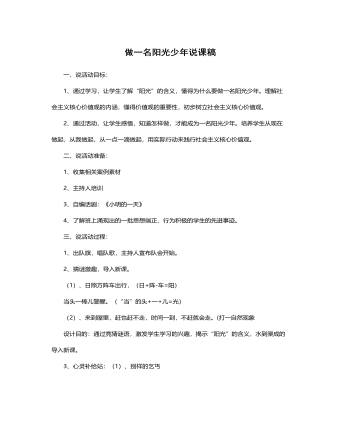
做一名阳光少年说课稿
1、紧密联系学生的生活实际,所选材料、所有活动均本着为主题服务的原则。2、形式多样化。通过心灵补给站、我来当编剧、心动不如行动等丰富多彩的活动,激发学生的热情,充分发挥他们的主体性。3、用生活中的真人真事激励他们,震撼他们的心灵,对学生进行教育,让他们得到感悟。五、说评价方式:要真正发挥主题队会的教育作用,千万不能把主题队会开成“检讨会”、“批评会”。兴趣是最好的老师,在课堂上,学生有了兴趣,才会有学习的动机,所以,在教学过程中,我努力把学生当作一个平等的朋友来对待,对于学生的回答进行评价时,本着“多表扬少批评,多鼓励少指责”的原则,尽量不用指令性、批评性的语言,最大限度的挖掘学生的优点,进行激烈性评价。

追思先烈魂,弘扬爱国情说课稿
环节四深入实践——弘扬爱国情爱国不是一句口号,要将爱国情怀落实到行动中去,队员们在各队队长的组织下,商讨出了落实方案。1、第一小队和第二小队组成了先烈故事演讲团,利用班会十分钟的时间,在三四年级宣讲先烈故事。2、第三小队和第四小队组成了创编小能手,编唱了爱国童谣、爱国拍手歌,告诉大家,爱国无处不在,爱国要从小事做起。3、第五小队和第六小队编写的爱国倡议书,提倡大家让爱国从口号落实到行动。4、全体队员共同宣誓:时刻准备着,为共产主义事业而奋斗,将活动推向了高潮。环节五大队辅导员总结“风雨沧桑,多遭铁蹄践踏,未有沉沦终奋起;荡涤污浊,重聚华夏精魂,披荆斩棘勇向前。”让我们牢记自己是中国人,怀一颗中国心,明确方向,努力奋斗,早日实现自己的梦想。
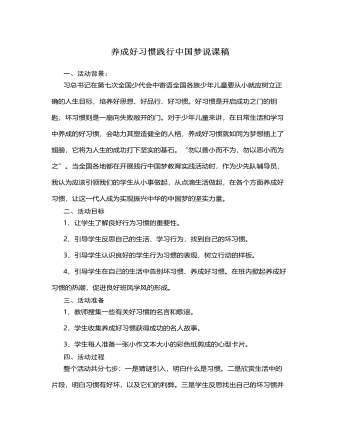
养成好习惯践行中国梦说课稿
第七步:全班学生一起倡读承诺书:(课件出示)我们都是小学生,培养习惯最要紧;上课应当专心听,积极开动小脑筋;作业认真仔细做,按时完成交得勤;有了错误要订正,知识才能学得清;人生要有好习惯,我们牢牢记心上。最后请学生把自己要养成的好习惯写在心意卡上,写好后粘贴在教室后面的园地里,互相督促,使得此次活动教育延续课后,直至影响一生.5、活动效果及反思此次活动开展后,学生们增强了对自身的认识,很多学生下决心改掉自身的坏习惯,并逐步采取了实际行动,从身边的小事做起,而且在学生中间还兴起了互相帮助、互相指正、争相进步的热潮。通过此次活动我也切实的体会到养成教育要开展就要落到实处,从实际出发,让学生亲自去感受,去体会,并且要持之以恒的做下去。同时作为老师更应该有一颗敏感热情的心,随时发现学生身上的闪光点与不足,多指正、多指点、多鼓励、多表扬,做到时时处处皆教育,这样才能赢得孩子,做好教育。
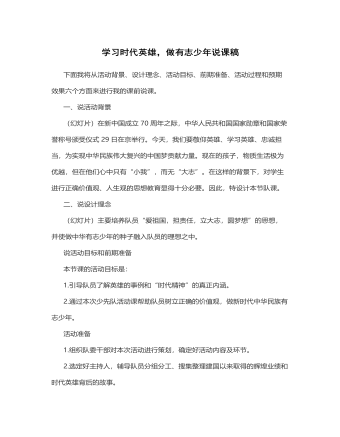
学习时代英雄,做有志少年说课稿
一、说活动背景(幻灯片)在新中国成立70周年之际,中华人民共和国国家勋章和国家荣誉称号颁受仪式29日在京举行。今天,我们要敬仰英雄、学习英雄、忠诚担当,为实现中华民族伟大复兴的中国梦贡献力量。现在的孩子,物质生活极为优越,但在他们心中只有“小我”,而无“大志”。在这样的背景下,对学生进行正确价值观、人生观的思想教育显得十分必要。因此,特设计本节队课。二、说设计理念(幻灯片)主要培养队员“爱祖国,担责任,立大志,圆梦想”的思想,并使做中华有志少年的种子融入队员的理想之中。说活动目标和前期准备本节课的活动目标是:1.引导队员了解英雄的事例和“时代精神”的真正内涵。2.通过本次少先队活动课帮助队员树立正确的价值观,做新时代中华民族有志少年。
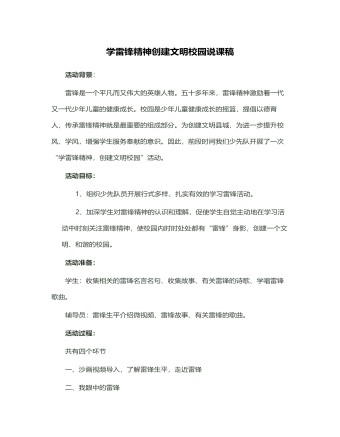
学雷锋精神,创建文明校园说课稿
雷锋精神是什么?这一环节是让学生用简单的词语或句子概括。通过这一活动,让学生概括出雷锋精神的内涵:像无私奉献、乐于助人、为人民服务、勤俭节约、尊老爱幼、勤奋好学、干一行爱一行、言行一致等等都是雷锋精神的体现。我们少年儿童是中国的未来和希望,雷锋精神的发扬和光大,创建文明校园的任务就落在他们的肩上,所以在这里我还设计了为发扬雷锋精神,创建文明校园“我该怎么做”这样的问题,目的就是让他们一起行动起来,学雷锋做好事,并制作了“荣誉”旗,奖励身边的好人好事。活动延伸:这里我设计了一个角色游戏活动——我要义卖献爱心,这个游戏学生们表现得非常积极,他们收集了自己不要的小文具或小玩具,将他们拿到集市上去卖,卖东西获得的钱,捐给王奶奶的孙女,因为王奶奶的孙女生病了,无钱治病。我觉得这个游戏使学生们懂得,一个人只要有爱心,只要愿意去帮助别人,无论什么方式都行,而且在游戏活动中孩子们体会到了帮助别人是一件多么多么快乐的事呀。
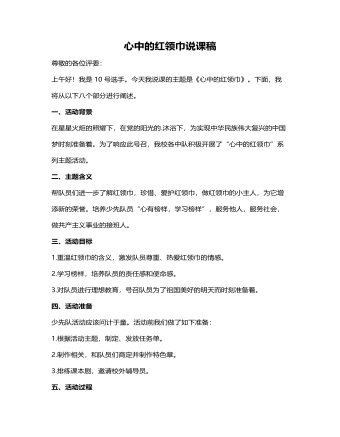
心中的红领巾说课稿
1.学习“最美红领巾”。图文结合,学习“美德少年”刘华婷、刘颖等人的先进事迹。2.记录“平凡红领巾”。展示队员们活动前精心准备的“随手拍”,发现普通队员在日常生活中的闪光点。3.填写“我为红领巾添光彩”心愿卡,对学生进行理想教育。4.齐唱《红领巾之歌》,点燃信念火种。5.辅导员对此次活动进行总结,并颁发特色章。(出示三个特色章图标)六、活动延伸红领巾精神需要代代相传,珍爱红领巾的意识需要时时提醒,本次活动后,我们会开展“小小新四军”、“鲜艳的红领巾”等后续活动,帮助队员们将红领巾精神永远铭记在心。七、引导要点四年级队员具备一定的活动能力和经验,通过课本剧的亲身体验、心愿卡的真情表达等多种方式的运用,引导队员热爱红领巾,以红领巾精神指引自己健康成长。八、活动评价本次活动,队员们受到了良好的教育。但是四年级队员自我约束能力不够强,缺乏持久性,萌生的意识和激情往往只停留在活动时,不能在活动后内化为自觉行为,这些问题有待探究。
今日更新Word
-
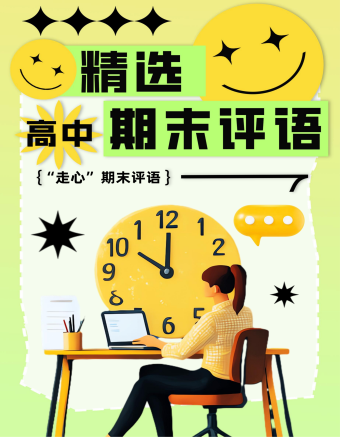
精选高中生期末评语
1、该生学习态度端正 ,能够积极配合老师 ,善于调动课堂气氛。 能够积极完成老师布置的任务。学习劲头足,听课又专注 ,做事更认 真 ,你是同学们学习的榜样。但是,成绩只代表昨天,并不能说明你 明天就一定也很优秀。所以,每个人都应该把成绩当作自己腾飞的起 点。2、 你不爱说话 ,但勤奋好学,诚实可爱;你做事踏实、认真、为 人忠厚 ,是一个品行端正、有上进心、有良好的道德修养的好学生。在学习上,积极、主动,能按时完成老师布置的作业,经过努力 ,各 科成绩都有明显进步,你有较强的思维能力和学习领悟力,学习也有 计划性,但在老师看来,你的潜力还没有完全发挥出来,学习上还要有持久的恒心和顽强的毅力。
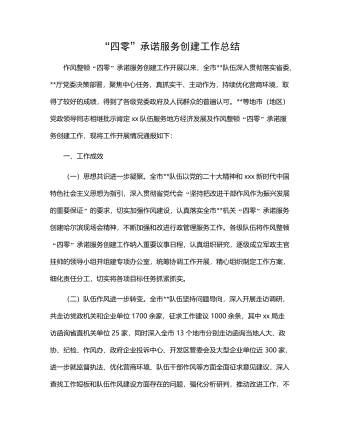
“四零”承诺服务创建工作总结
(二)坚持问题导向,持续改进工作。要继续在提高工作效率和服务质量上下功夫,积极学习借鉴其他部门及xx关于“四零”承诺服务创建工作的先进经验,同时主动查找并着力解决困扰企业和群众办事创业的难点问题。要进一步探索创新,继续优化工作流程,精简审批程序,缩短办事路径,压缩办理时限,深化政务公开,努力为企业当好“保姆”,为群众提供便利,不断适应新时代人民群众对政务服务的新需求。(三)深化内外宣传,树立良好形象。要深入挖掘并及时总结作风整顿“四零”承诺服务创建工作中形成的典型经验做法,进一步强化内部宣传与工作交流,推动全市创建工作质效整体提升。要面向社会和公众庄严承诺并积极践诺,主动接受监督,同时要依托电台、电视台、报纸及微信、微博等各类媒体大力宣传xx队伍作风整顿“四零”承诺服务创建工作成果,不断扩大社会知情面和群众知晓率。
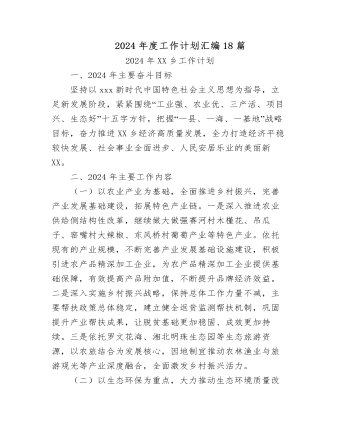
2024年度工作计划汇编(18篇)
1.市政基础设施项目5项,总建设里程2.13km,投资概算2.28亿元。其中,烔炀大道(涉铁)工程施工单位已进场,项目部基本建成,正在办理临时用地、用电及用水等相关工作;中铁佰和佰乐(巢湖)二期10KV外线工程已签订施工合同;黄麓镇健康路、纬四路新建工程均已完成清单初稿编制,亟需黄麓镇完成图审工作和健康路新建工程的前期证件办理;公安学院配套道路项目在黄麓镇完成围墙建设后即可进场施工。2.公益性建设项目6项,总建筑面积15.62万㎡,投资概算10.41亿元。其中,居巢区职业教育中心新建工程、巢湖市世纪新都小学扩建工程已完成施工、监理招标挂网,2月上旬完成全部招标工作;合肥职业技术学院大维修三期已完成招标工作,近期签订施工合同后组织进场施工;半汤疗养院净化和医用气体工程已完成招标工作;半汤疗养院智能化工程因投诉暂时中止;巢湖市中医院(中西医结合医院)新建工程正在按照既定计划推进,预计4月中下旬挂网招标。

驻村工作队2024年第一季度工作总结汇编(4篇)
三是做大做强海产品自主品牌。工作队于xx年指导成立的冬松村海产品合作社,通过与消费帮扶平台合作,在工作队各派出单位、社会团体、个人支持下,已获得逾xx万元销售额。2022年底工作队推动合作社海产品加工点扩建的工作方案已获批,待资金下拨后将正式启动扩建工作。四是积极助企纾困,带动群众增收致富。工作队利用去年建立的xx镇产业发展工作群,收集本地企业在产品销售、技术、人力、资金、运营、用地等方面的需求,并加大xx支持乡村振兴力度,xx助理赴各村委开展多场xx政策支持乡村振兴宣讲活动,本季度有x万元助农贷款获批,xx万贷款正在审批中。在壮大既有产业的同时,完善联农带农机制,一方面鼓励企业雇用本地农户就业,另一方面计划与本地农户签订长期收购合同,让农民种得放心、种得安心,带动当地群众共同致富。

主题教育总结常用提纲大全
第一,主题教育是一次思想作风的深刻洗礼,初心传统进一步得到回归。第二,主题教育是一次沉疴积弊的集中清扫,突出问题进一步得到整治。第三,主题教育是一次强化为民服务的生动实践,赤子之情进一步得到提振。第四,主题教育是一次激发创业担当的有利契机,发展层次进一步得到提升。2.第一,必须提领思想、武装思想。第二,必须聚焦问题、由表及里。第三,必须领导带头、以上率下。第四,必须务实求实、认真较真。3.一是抬高政治站位,坚持大事大抓。二是坚持思想领先,狠抓学习教育。三是突出问题导向,深入整改纠治。四是坚持领导带头,发挥表率作用。4.一是立足“早”字抓筹划。二是着眼“活”字抓学习。三是围绕“统”字抓协调。5.一是形势所需。二是任务所系。三是职责所在。四是制度所定。6.一要提升认识。二要积极作为。三要密切协作。
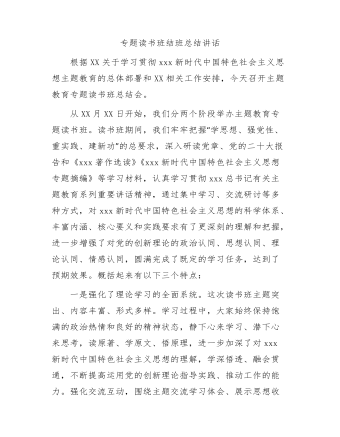
主题教育专题读书班结班总结讲话
第二,要把调查研究贯穿始终,实干担当促进发展。开展好“察实情、出实招”“破难题、促发展”“办实事、解民忧”专项行动,以强化理论学习指导发展实践,以深化调查研究推动解决发展难题。领导班子成员要每人牵头XX个课题开展调查研究,XX月底前召开调研成果交流会,集思广益研究对策措施。各部门、各单位要制定调研计划,通过座谈访谈、问卷调查、统计分析等方式开展调查研究,解决工作实际问题,帮助基层单位和客户解决实际困难。第三,要把检视问题贯穿始终,廉洁奉公树立新风。认真落实公司主题教育整改整治工作方案要求,坚持边学习、边对照、边检视、边整改,对标对表xxx新时代中国特色社会主义思想,深入查摆不足,系统梳理调查研究发现的问题、推动发展遇到的问题、群众反映强烈的问题,结合巡视巡察、审计和内外部监督检查发现的问题,形成问题清单。


















